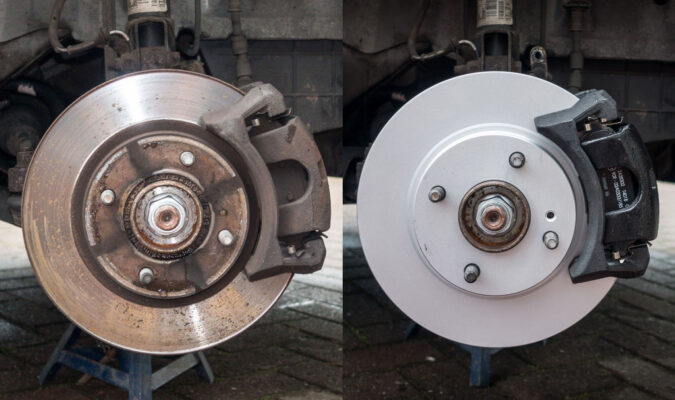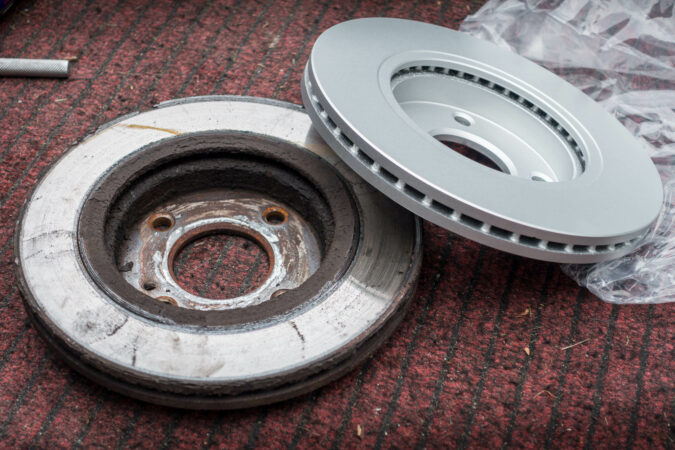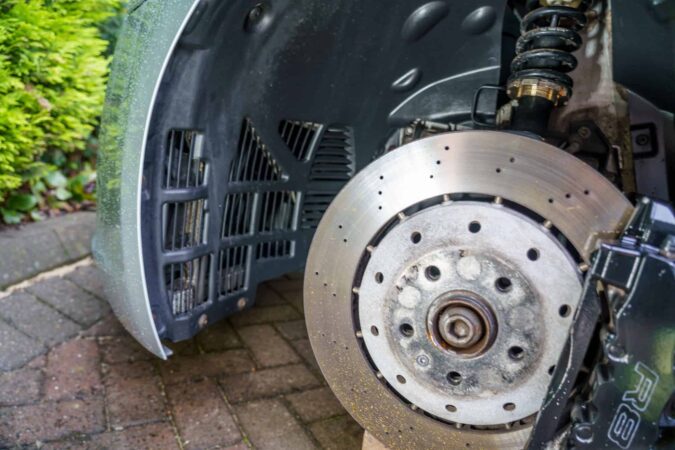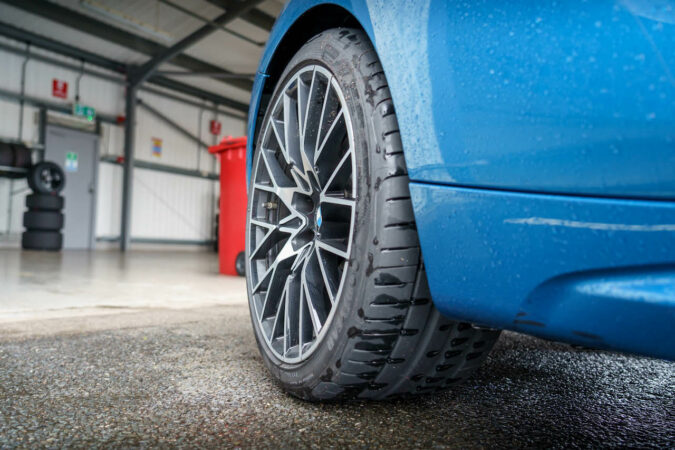It never ceases to surprise me as to how much you can learn about a car through the steering wheel. You can feel if the car is driving properly, or if a single shiver could be the car telling you something’s amiss. With that in mind, what does a car inform you when the steering wheel shakes at low speeds?
It’s terrifying enough to have the steering wheel – where a 2-tonne slab of metal is controlled – wobble under normal circumstances. But imagine it happening while you’re driving, no matter how fast.
So, what’s causing this problem where the steering wheel shakes at low speeds? Unfortunately, and given how complex a car is underneath the flesh, there could be a myriad of faults at play.
When it shakes or vibrates violently, it could point to faulty brakes, suspension, steering, tires, or anywhere in between. That is quite a wide net to cast, but at least we have a starting point. So, let’s see what goes on if the steering wheel shakes low speeds issue crops up, and how we can solve it.
- Common Causes & Reasons Why
- Average Fixes And Repair Costs
- Final Conclusion
- Frequently Asked Questions (FAQs)
Steering Wheel Shaking
Your car is, naturally, never made to shake, vibrate, and shudder. That’s especially following decades of refinement to design automobiles as civilized as possible, without a shiver in sight.
Therefore, this concern where the steering wheel shakes at low speeds is a tell-tale symptom where parts of your car need a check-up. It’s more than plausible that certain components may have worn out, and aren’t running as well as they should. Or, it could be that some of those parts have failed altogether.
If any of these happens, you could feel something odd reverberating across the steering wheel. The symptom might exhibit more prominently at low (which is what we’re looking at) or at higher speeds.
Alternatively, it might only appear when you’re braking or turning. In any case, when your steering wheel shakes at low speeds, it’s worth getting it looked into right away. But what exactly is causing it? As we noted earlier, it could be attributed mainly to either the steering, suspension, brakes, or tires.
Thus, and based on how bad the shaking is, the underlying problem could be trivial or severe. Here’s a more in-depth summary of what could be causing the steering wheel to shake or shudder at low speeds, separated by distinct sections of your car…
Steering Wheel Shakes Low Speeds, Causes #1: Brakes (Worn Out Or Faulty)
Your car’s brakes are arguably the most suspect culprit when the steering wheel shakes at low speeds. However, it should be noted that brake-related faults usually only appear through a shaky steering wheel when you’re on the brakes. Should your foot stay off the brake pedal and move, it might not display any defects. Nevertheless, the brakes do undergo an immense amount of strain.
Constant exposure to friction, heat, and the elements culminates in its susceptibility to wear out fast and fail if not serviced correctly. When this does happen, you may certainly be able to feel it through a shuddering or shaking steering wheel. The automotive braking system can be split into four distinct units – rotors (or discs), pads, calipers, and brake lines.
So, let’s take a look at each one, and see how they could result in your steering wheel shakes low speeds…
1.1 Rotors – Unevenly Worn Or Warped
The rotors are the large plate-sized discs that the brake pads clamp onto. By rubbing against the discs, your brake pads generate friction and heat. This helps to gradually – or rapidly, depending on the brakes – slow down, and then stop your car. It’s vital therefore that the brake rotor discs are as even and smooth of a surface as possible. This enables the pads to exert a uniform braking force.
However, constant heat and wear can damage the rotors over time. For example, some sections of the rotors might be more worn than others. Or, the heat may have been intense enough to melt and warp or twist the discs. If this is the case, and when you press the brake pedals, the brakes can’t distribute the braking force evenly. As a result, you’ll be left with poorer braking performance.
At the very least, you can notice that it takes longer and further for your car to come to a halt. On top of that, your car might pull to one side when braking, as the more structurally sound rotor could perform better.
Moreover, the steering wheel shakes at low speeds, as the pads are constantly grinding against warped and uneven brake rotors when they’re making contact with the surface. The same also goes to worn brake pads.
1.2 Brake Pads – Worn Out
Speaking of pads, brake pads are a commonly replaceable item. This is due to it being the friction pad that continually goes through a lot of heat and friction in day-to-day driving. Plus, it’s the surface of the brake pads that slowly wears itself out. The lifespan of your brake pads can vary from around 20,000 miles to over 70,000 miles. Some could even last to upwards of 80,000 miles or more.
It’ll depend on the quality of pads you have, and how you use them. That said, technicians are quick to establish a 40,000-mile estimate on average. This is a good interval for you to have your brake pads checked out. Should they wear down to a less-than-ideal condition, you’ll be able to feel a noticeable drop in braking performance, as well as odd noises such as squealing or squeaking.
And let’s not get started with loud grinding sounds, as this is an indication that the brake pads have worn out completely. Now, the metal backing of the pads is rubbing against the brake discs, which is a recipe for destroying your brakes. To top it all off, you can sense it if the steering wheel shakes at low speeds, as the worn-out brake pads couldn’t make uniform contact with the discs.
1.3 Callipers – Rusty Or Sticking
If you don’t already know, the brake calipers are what clamp the brake pads down onto the rotors. Thus, the condition of the calipers must be maintained. After all, it’s not just the friction and heat that it needs to handle. Sitting outside, it’s continually exposed to the elements with water, dirt, dust, mud, oil, debris, bugs (unless you know how to remove bugs from car), and anything else that you might encounter on the road.
If the steering wheel shakes at low speeds, the brake calipers may be ‘sticking’. This simply means that the calipers are stuck in place. It might be stuck downwards, as the calipers are grinding the pads down onto the rotors, even as you lift the brake pedal. In this case of brake calipers seizing up, it’ll no doubt cause other issues as well, such as poor – or unwanted – braking performance.
We can point the finger at rust for this. Moisture can get trapped within the braking system, such as between the hard-to-reach spots of the calipers, they’re met with high temperatures of the brakes.
Over time, this can cause it to oxidize. The calipers’ pistons might be rusted away to a point where they can’t force the calipers up or down. Alternatively, the pistons might be blocked by a wall of rust.
1.4 – Brake Lines – Air Bubbles
Connecting the calipers, pads, and rotors over to you, would be the brake lines. These are the hoses and tubing that carry brake fluid. As a pressurized liquid, it translates your input on the brake pedal into motion along the braking system. It’s therefore quite important to maintain the condition of the brake fluids. Unfortunately, and if not cared for, they can be compromised over time.
One such consequence would be the formation of air bubbles in the brake lines. This can be caused by a build-up of moisture in the brake lines. When the brakes start functioning, we know that it emits a lot of heat. The high temperatures are more than enough to turn the moisture into its gaseous state. This then is how pockets of air form up within the brake fluid’s flow.
We also have to look at other contaminants that might’ve gotten into the circulation, which may get in the way of the brake fluid’s performance. If there are air bubbles, the brake fluid can’t maintain an evenly distributed hydraulic pressure. This is how one side of the brakes might work better than the other, and so on. One familiar symptom of this is when the steering wheel shakes at low speeds.
Steering Wheel Shakes Low Speeds, Causes #2: Suspension (Worn Out Or Faulty)
The next point of failure that could be the cause of when your steering wheel shakes at low speeds is the suspension. As the suspension and steering are closely connected to one another, any problem with your suspension can lead to shuddering on the wheel. The slightest of vibrations could point out to major components having worn out their shelf life, or have failed entirely.
The suspension does a lot of work in ironing out all those bumps and undulations on the road as you drive along. This dampening process takes a toll on the suspension, especially if you regularly drive over rough roads. Sharp impacts against potholes or debris on the road will stress out the suspension even further. To settle this, we can break the suspension down into four parts.
These include the inner and outer rods, ball joints, or the control arm bushings…
2.1 Inner And Outer Rods – Worn Out
The inner and outer suspension rods have a very important role to play – keep the wheels in their set position. After some time, though, both the inner and outer rods could wear out. When this happens, the wheels could be left imbalanced, as they shift in or outwards slightly. This can lead to numerous issues down the line, such as uneven tread wear, or the car veering left and right.
Even just 1mm out of alignment is more than enough for this to happen. Another side effect of the inner and outer rods failing is if the steering wheel shakes at low speeds. Generally, you’ll only feel this if you start turning your car, rather than keep on driving in a straight line. Nevertheless, you can feel it calling out for a check-up if the vibrations and shuddering are felt through the wheel.
2.2 Ball Joints – Worn Out, Or Damaged
Sometimes referred to as suspension ‘bearings’, they can be found on both ends of the tie rods. The ball joints (or bearings) aid in absorbing a lot of strain and pressure within the suspension.
On top of that, it works to soften out any vibrations that you may have otherwise felt while driving, even over rough and bumpy terrain. That said, the ball joints go through a lot of stress.
Hence, it can wear out and fail over time if not maintained or replaced. A lot of suspension-related symptoms can crop up when they do break. Among them would be when the steering wheel shakes at low speeds or another similar shuddering. Unlike the inner and outer rods, a worn-out or damaged ball joint can be confirmed if the shaking occurs while you’re driving straight, not turning.
2.3 Control Arm Bushing – Worn Out Or Bent
In your car’s suspension, there’s such a thing as the control arm along the front and rear. These are the hinged links that connect the wheels – and the rest of the suspension – to the chassis of the car.
On those control arms are the bushings, which protect it from excess pressure or strain when working the car’s suspension. The control arms are key stress points in your car’s suspension.
It’s no wonder then that they’re among the suspension-related componentry that needs replacing the most. If the control arm bushings do wear out, bend, or completely fail due to the strain, it can duly result in the wheels not being correctly aligned. This wheel misalignment will cause other issues. The most prominent of these is the fact that the steering wheel shakes at low speeds.
Steering Wheel Shakes Low Speeds, Causes #3: Tires And Wheels (Pressure, Balancing, Treads)
If there’s one common denominator to what causes the steering wheel to shake at low speeds, regardless of any condition or speed, it would be the tires. The condition of your car’s tires can be quite apparent by the sensation you feel through the steering wheel. Are some of your tires underinflated, or is the tread wear worn out beyond use? You’d be able to tell instantly.
It’s naturally hard to pinpoint a particular use-by-date for tires, but it’s good to have them checked out once every 20,000 miles or so. It will vary widely, of course, depending on what brand or type of tires you’re running. If we’re looking at what’s causing your steering wheel to shake while driving at low speeds, we can break down the tire-related reasons for why it’s happening…
3.1 Uneven Treadwear, Lack Of Balancing
Your tires should wear out their tread – or contact patches – evenly. One exception is the fact that the front tires will almost always wear out faster than the rear tires. In most cars, the front rubber is the one that has to handle all of the steering, and most of the braking. For front-wheel-drive cars especially, the added responsibility of having to moderate power will wear it down faster.
However, there are circumstances where the treadwear is oddly uneven. Misalignments, which we’ve mentioned earlier, can lead to saying, the outer sidewalls of the tires wearing out quickly.
Or, you may be able to see bald spots. When this happens, the tires can’t glide smoothly over the surface of the road anymore. This is then followed by the instance that the steering wheel shakes at low speeds.
3.2 Not Enough Tire Pressure
This is quite a simple fix, but could nonetheless be a probable reason as to why your steering wheel shakes at low speeds. The tire pressure has to be similar across all four tires. Should there be one tire that remains underinflated – or overinflated, in an alternate situation – the other three tires will have to compensate. Doing so will lead to uneven tread wear on your tires.
You should always refer to your owner’s manual to find the recommended pressure for your tires and always keep them leveled. If not, you’ll face problems such as the car veering slightly left or right, or if the braking isn’t as good. Perhaps the ride might not be as comfortable as it used to be. Or, the steering wheel shakes at low speeds, as well as other vibrations, could be felt.
3.3 Wheels/Steering – Bent Or Damaged
It might seem like a piffling matter, but your wheels getting bent is one possible cause of why your steering wheel shakes at low speeds. For instance, the wheels (or rims) may have been shattered or cracked during an accident. This seemingly light damage is preventing the wheels from being able to roll around smoothly in a circular motion, as the cracks get in the way.
The compromised structure of the wheels may have an effect too, as it can cause shuddering or vibrations. Even more serious is what happens underneath all that. If that collision is a hard one, it can damage the axles or the driveshaft. In either case, you can feel the car jerking left or right, as well as that steering wheel shake when you’re cruising at low speeds.
Steering Wheel Shakes Low Speeds, Causes #4: Drivetrain Components
As we delve deeper into possible reasons for steering wheel shakes at low speeds, it’s crucial to not overlook the car’s drivetrain.
4.1 Damaged CV Joints
The Constant Velocity (CV) joints play an integral role in transferring power from the engine to the wheels. When a CV joint wears out or gets damaged, it can cause irregularities in power distribution, leading to vibrations. A clicking or popping sound when turning is a common sign of a faulty CV joint.
4.2 Unbalanced Drive Shaft
Particularly in rear-wheel-drive vehicles, the drive shaft’s balance is essential for smooth operation. If it becomes unbalanced, perhaps due to wear or damage, it can lead to vibrations felt in the vehicle, including the steering wheel.
Steering Wheel Shakes Low Speeds, Causes #5: Engine-Related Issues
The engine is the heart of your car. Any issue here can manifest itself in various ways, including through your steering wheel.
5.1 Engine Misfires
A misfire means the engine isn’t firing on all cylinders. This lack of power can lead to overall car vibrations that you might feel through the steering wheel. Causes for misfires range from spark plug issues to fuel injector problems.
5.2 Damaged or Loose Engine Mounts
Engine mounts hold the engine in place. If they’re damaged or become loose, they won’t effectively dampen the engine’s natural vibrations, leading to increased shaking or vibrations felt inside the car, including through the steering wheel.
The steering wheel is your primary interface with your vehicle. When it starts to shake, especially at low speeds, it’s a clear sign that something might be amiss. Whether it’s issues with your brakes, suspension, tires, drivetrain, or even the engine, it’s essential to address these problems promptly. Regular maintenance checks and paying attention to your car’s performance will go a long way in ensuring smooth rides and prolonged vehicle life.
Steering Wheel Shakes Low Speeds Fixes
So then, we’ve gotten through some of the most common causes of why your car’s steering wheel shakes low speeds driving. Now, you’ll be curious to know what it takes to get it all fixed.
This is one automotive repair that should be done promptly, as it could cause an accident if not resolved soon. With that in mind, here’s a quick rundown of what you can do to fix this issue. More importantly, we’ll look at how much they approximately cost…
Brake Rotor Disc Resurfacing – If the discs are worn unevenly, they can still be resurfaced, rather than replaced. A resurfacing job will grind away the rough surface and would cost you around $30 to $100 per rotor.
Brake Rotor Disc Replacement – Should the brake rotors be warped or are severely damaged, only a replacement will do. Performant rotors can cost you at least $150 for a single unit. For most cars though, expect a price tag of around $30 to $150 each. It’s recommended that you replace an entire axle’s worth – two wheels, front or rear – at a time, instead of just one rotor. If we add in the labor charges on top of two rotors, you can expect a bill between $200 to $500 for each axle.
Brake Pads Replacement – Just like rotors, brake pads should be replaced in pairs for each axle. The pads cost anywhere from $35 to $150 for one set (two per axle). Accounting for the labor charges, the total price will be around $100 to $300 per axle. If you’d like to save on labor fees, you can replace the pads and rotors together, for an expense of about $250 to $600.
Wheel, Tire, & Suspension Repair
Wheel Alignment And Rebalancing – Depending on your car – and the technician’s diagnosis – you may need a four- or two-wheel alignment done for your wheels. Usually, 4x4s and all-wheel-drive cars need a full four-wheel alignment, for $100 to $150 on average. For most cars, you could make away with a two-wheel alignment, setting you back $50 to $75 for the whole.
Tire Rotation – Since you’re getting your wheels aligned, you could have them rotated, as well. The common price associated with tire rotations is around $25 to $50 (to learn more, check out our guide on tire rotation and balance cost near me). However, some tire retailers offer you free rotations throughout the lifespan of the tire.
Suspension Bits And Pieces – Here, we’ll just look at all the repair costs for your suspension system. If the shocks or struts need a replacement, a set of four – one for each wheel – will set you back $200 to $1,500. You could opt for a refurbished set or a DIY shock and strut kit for $250 to $350. The control arms and ball joints, meanwhile, are between $350 to $2,000. Once again, that’s for a whole set of four, but you could get DIY kits for less than $400.
Steering Wheel Shakes Low Speeds: In Conclusion…
This rounds off our look at all the most typical reasons and their respective fixes that involve your car’s steering wheel shaking at low speeds. As a whole, it’s no doubt a very urgent problem to have it checked out and then fixed as soon as possible.
For starters, all this shaking is merely a prelude to things to come. If you don’t find out what’s causing it, and then repair the worn-out or faulty component in mind, it will only get worse later on. The bills can only get higher from here on out.
Steering Wheel Shakes Low Speeds: Frequently Asked Questions (FAQs)
If you’re still curious to learn more about why your steering wheel shakes at low speeds, our FAQs here might help…
Why Does My Car Shake When I Brake
There are numerous reasons to explain why your car shakes under braking. Oftentimes, the root cause is the brakes themselves. So, check to make sure that your brake pads are still in good shape, the brake rotors aren’t unevenly worn, and if the brake calipers are sticking. Beyond that, you’ll have to inspect the tires and wheels. A bad alignment and balancing would cause your car to shake under braking. As is, brake lines that have air bubbles trapped in them. Or, if there are faulty components within your suspension and steering assemblies, ranging from faulty wheel bearings, tie rods, and ball joints.
Why Is My Car Shaking When I Drive
If your car is shaking and vibrating while you’re driving along normally, this could be attributed to several issues. The brakes are most often the likeliest suspect, which would cause your car to become unstable. This is due to warped brake rotors, worn-out brake pads, sticking calipers, or the presence of air bubbles in the brake lines. Other than that, faulty suspension parts might also cause this shaking, too. Specifically, with worn-out tie rods, bad ball joints, or bent control arm bushings. Driving with the wrong tire pressure, misaligned wheels, or unbalanced tires might further exacerbate this issue, as well.
Why Does My Steering Wheel Shake At High Speeds
When you notice the steering wheel shaking and vibrating at higher speeds, this is often due to a select few problems. Mainly, the tires might be wearing unevenly or have not been inflated at the right pressures. Other than that, bad wheel alignments and unbalanced tires might also cause the steering wheel to shake. Any faults with the ball joints, wheel bearings, and tie rods might cause this issue, too. Plus, the shaking becomes even more noticeable at higher speeds. Bent axles, bad brakes, and worn-out engine mounts are among the few other underlying issues that cause your steering wheel to shake and vibrate at higher speeds.
What Causes Steering Wheel Play
A steering wheel should always feel tight and firm, without any excessive play or looseness. If you are noticing this, then it might be indicative of problems brewing in your car. For the most part, this might be due to worn-out tie rods or faulty ball joints. When these two fail, you might also notice other symptoms such as odd noises, as well as problems with the steering, such as your car veering left and right. Otherwise, you might have to check other parts of your car’s steering (and even suspension) set-up. You’d be wise to closely inspect the steering gearset, rack and pinion, linkages, control arm bushings, or ball joints.
How To Tighten Steering Wheel
If the steering wheel has too much play or excessive looseness, there are ways to fix this. However, the processes required will be dependent on what caused the steering wheel play, in the first place. Normally, a good wheel alignment and tire balancing should help to get your car tracking straight and true again. Otherwise, if the steering gear and mounts are loose, tightening these should help with excess steering wheel play. Beyond that, worn-out parts, such as wheel bearings, tie rod ends, or steering couplings should be replaced outright.





